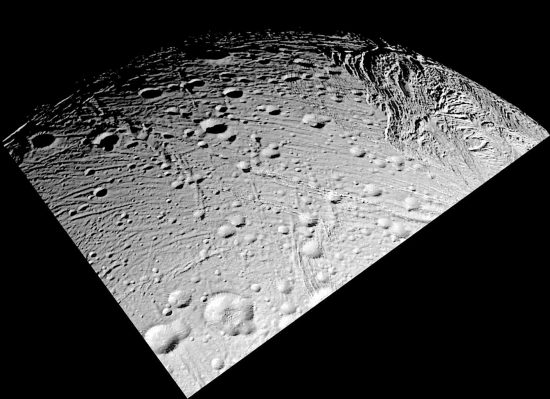
The south polar region of Enceladus. Credit: NASA/JPL/Space Science Institute.
Jun 1, 2016
Electricity is the active agent on Enceladus.
A previous Picture of the Day announced that the Cassini space probe, currently orbiting Saturn, was about to fly through one of the plumes of vapor that erupt from the southern plains of its moon, Enceladus. Enceladus is a small moon, only 494 kilometers in diameter, with a surface that is so cold that no chemical reactions can occur. Mission specialists believe that its putative “briny ocean” will allow them to plan and fund more missions.
A recent press release states that observations of a star as it passed behind a plume from the Baghdad Sulcus region indicated that there was too little gas in the eruption to account for an increase in dust output. A counter-intuitive fact about the plumes is that dust output increases when Enceladus is farthest from Saturn in its orbit. As the announcement states, “…the data from that observation had scientists scratching their heads. What they saw didn’t fit their predictions.”
In the consensus view there is only friction and gravity to account for the behavior of celestial bodies. Saturn’s gravity is thought to act like a tidal force: Enceladus is squeezed and pulled in Saturn’s gravitational grip. Its internal structure is said to stretch and compress, creating enough heat to form a liquid ocean more than 15 kilometers beneath the ice.
Larry Esposito from the University of Colorado said:
“We had thought the amount of water vapor in the overall plume, across the whole south polar area, was being strongly affected by tidal forces from Saturn. Instead we find that the small-scale jets are what’s changing.”
Dr. Candice Hansen concluded:
“Since we can only see what’s going on above the surface, at the end of the day, it’s up to the modelers to take this data and figure out what’s going on underground.”
On August 11, 2008 Cassini found ion and electron beams propagating from Saturn’s northern hemisphere. Emissions from Enceladus’ south polar vents corresponded with the auroral footprint’s brightness variations on Saturn. Since several of Saturn’s moons eject charged particles along field-aligned electric currents it should not be surprising that Enceladus is among them.
Streams of charged particles from the Sun are captured by Earth’s magnetosphere, along with ions generated by Earth itself, where they are held together by Earth’s magnetotail. Cassini observed the particles in Saturn’s magnetotail changing: ionized water ions disappeared while H+ ions took their place, an observation consistent with charge flow (ionized particles) from Saturn’s upper atmosphere. Saturn is electrically connected with the Sun, so interactions between Saturn and its moons means that they are charged bodies. Saturn exists in a dynamic electrical relationship with its orbiting family.
The problems with jets on Enceladus are similar to those that space scientists have with cometary jets. They are using the same weak theory of narrow surface vents above a chamber of hot water. There is no evidence for such vents, either on comets or on Enceladus.
Electric Universe advocate Wal Thornhill suggests that jets travel across the surface because they are created by electric discharges. Electric arcs cut channels as they remove material and accelerate it into space. A parallel to the Enceladus plumes are the “volcanoes” on Jupiter’s moon Io, which moved many kilometers across the surface over a few decades, excavating material and accelerating it upward in jets that precisely match the predictions of a “plasma gun” effect.
The cracks and “vents” on Enceladus look similar to those on Jupiter’s moon Europa. The tiger stripes are part of an intricate complex of channels that match the behavior of electric arcs in laboratory experiments.
Stephen Smith












